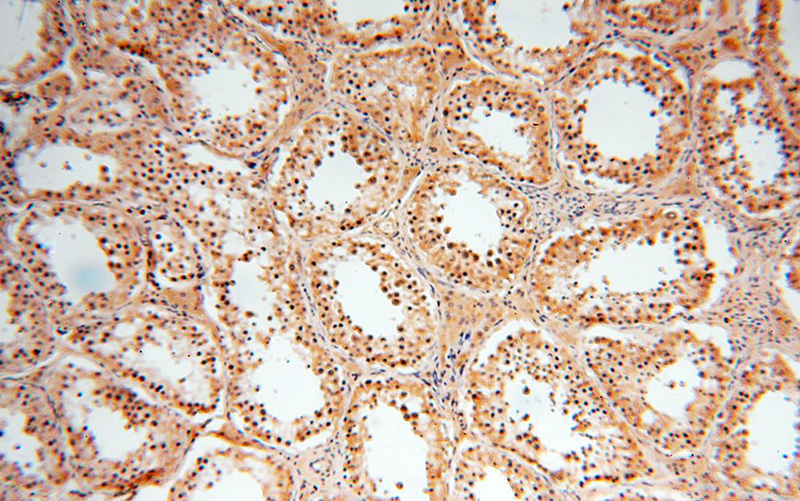-
Product Name
GPD2 antibody
- Documents
-
Description
GPD2 Rabbit Polyclonal antibody. Positive WB detected in mouse skeletal muscle tissue, mouse liver tissue, mouse pancreas tissue. Positive IP detected in mouse skeletal muscle tissue. Positive IHC detected in human testis tissue, human brain tissue, human spleen tissue. Observed molecular weight by Western-blot: 68 kDa
-
Tested applications
ELISA, WB, IHC, IP
-
Species reactivity
Human,Mouse,Rat; other species not tested.
-
Alternative names
GDH2 antibody; GPD M antibody; GPD2 antibody; GPDH M antibody; GPDM antibody; mGPDH antibody; mtGPD antibody
-
Isotype
Rabbit IgG
-
Preparation
This antibody was obtained by immunization of GPD2 recombinant protein (Accession Number: BC019874). Purification method: Antigen affinity purified.
-
Clonality
Polyclonal
-
Formulation
PBS with 0.02% sodium azide and 50% glycerol pH 7.3.
-
Storage instructions
Store at -20℃. DO NOT ALIQUOT
-
Applications
Recommended Dilution:
WB: 1:1000-1:10000
IP: 1:500-1:5000
IHC: 1:20-1:200
-
Validations

mouse skeletal muscle tissue were subjected to SDS PAGE followed by western blot with Catalog No:111063(GPD2 antibody) at dilution of 1:800

Immunohistochemical of paraffin-embedded human testis using Catalog No:111063(GPD2 antibody) at dilution of 1:100 (under 10x lens)

Immunohistochemical of paraffin-embedded human testis using Catalog No:111063(GPD2 antibody) at dilution of 1:100 (under 40x lens)

IP Result of anti-GPD2 (IP:Catalog No:111063, 3ug; Detection:Catalog No:111063 1:1000) with mouse skeletal muscle tissue lysate 3600ug.
-
Background
GPD2(Glycerol-3-phosphate dehydrogenase, mitochondrial) belongs to the FAD-dependent glycerol-3-phosphate dehydrogenase family.It is phosphorylated only in capacitated hamster spermatozoa and is noncanonically localized in the acrosome and principal piece in human, mouse, rat, and hamster spermatozoa, though in somatic cells it is localized in the mitochondria. This noncanonical localization may imply a role of GPD2 in acrosome reaction and hyperactivation(PMID:19333995 ).
-
References
- Joshi M, Eagan J, Desai NK. A compound heterozygous mutation in GPD1 causes hepatomegaly, steatohepatitis, and hypertriglyceridemia. European journal of human genetics : EJHG. 22(10):1229-32. 2014.
- Orr AL, Quinlan CL, Perevoshchikova IV, Brand MD. A refined analysis of superoxide production by mitochondrial sn-glycerol 3-phosphate dehydrogenase. The Journal of biological chemistry. 287(51):42921-35. 2012.
Related Products / Services
Please note: All products are "FOR RESEARCH USE ONLY AND ARE NOT INTENDED FOR DIAGNOSTIC OR THERAPEUTIC USE"
